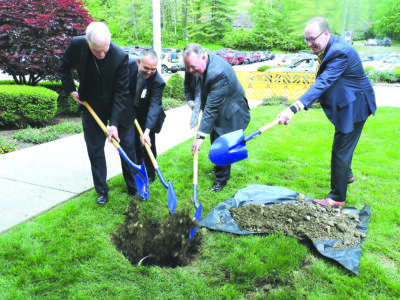NIH and Vance working together to find answers for EP, director says

AP Photo Vice President JD Vance, right, speaks with East Palestine Fire Chief Keith Drabick, center, during a visit to East Palestine, Ohio, Monday, Feb. 3, 2025. Ohio governor Mike DeWine, left, looks on. See A5 for more information on the restoration of the derailment site in East Palestine.
EAST PALESTINE, Ohio — Jayanta “Jay” Bhattacharya, the new director of the National Institutes of Health, told Fox news Thursday that the NIH and Vice President JD Vance hope to address the public health concerns caused by the 2023 Norfolk Southern train derailment.
“One thing that most people don’t know about is we’ve been working with Vice President Vance to look at a study and to find answers for people affected in East Palestine by that train disaster that happened during the Biden administration,” he said. “Shockingly the NIH had not asked that question.”
It is not clear exactly when that study will be rolled out or what that study will consist of.
Despite Bhattacharya’s stance that the NIH under President Joe Biden’s administration failed to address health concerns related to the derailment, the NIH has not turned a blind eye to the potential epidemiological impacts of the disaster.
In the summer following the derailment, Aubrey Miller, who led the Disaster Research Response Program at the National Institute of Health, took part in an informational session with the community on public health, and Biden, during a trip to the area in February 2024, announced the award of six NIH to research institutions to study the short- and long-term impacts of the derailment. The grants were split up between the University of Pittsburgh, California University at San Diego, Case Western and Texas A&M, and the National Institute of Environmental Health Sciences made the awards through its Time-Sensitive Research Grants Program.
The NIEHS also held a series of virtual public workshops in November 2023 to explore potential health research and surveillance priorities arising from the derailment and hear from residents impacted. The workshops featured local medical practitioners who offered insight and reflected on the health and environmental impacts of the derailment. Other workshop panels brought together exposure, public health and medical experts, as well as individuals from other communities that have experienced environmental disasters such as the water crisis in Flint, Michigan. The workshop also discussed the potential long-term impacts of the derailment on community health, and how future research efforts best involve local communities.
Still, most residents feel true answers to their health questions have been lacking and Vance, a junior U.S. senator at the time of the disaster, seemingly agreed as he advocated for more federal action for East Palestine under Biden.
Among the efforts by Vance was a letter to then-federal Environmental Protection Agency Administrator Michael Regan requesting the EPA to explore the applicability of the Comprehensive Environmental Response, Compensation, and Liability Act of 1980 to make a determination whether the crisis caused by Norfolk Southern’s derailment meets the criteria of a public health emergency under the law. CERCLA allows the EPA such authority when any hazardous substance is released into the environment and may present an imminent or substantial danger to the public health or welfare.
The request wasn’t without precedent. In 2009, the EPA made a public health emergency determination under CERCLA for the town of Libby, Montana, where 10 percent of the residents have been diagnosed with an asbestos-related illness linked to mining operations. That determination allowed Libby access to free medical care as offered under Social Security Act 1881a, which was drafted specifically for the residents in the tiny Rocky Mountain town of 4,000. The little-known clause in the Affordable Care Act grants free Medicare to citizens exposed to environmental disasters. In the 2023 letter, Vance asked for Social Security Act 1881a to be implemented for East Palestine and other areas affected by the rail disaster.
Vance has also criticized Biden’s decision to not declare a Presidential Disaster for East Palestine, which would have unlocked key resources for those impacted.
Aside from Bhattacharya’s statement that the NIH and Vance are working together to find answers for East Palestine residents, there has been no mention if Lee Zeldin — the current federal EPA administrator under Trump — will use CERCLA to declare the derailment a public health emergency or if Trump will make the declaration of disaster for East Palestine and the surrounding areas.






